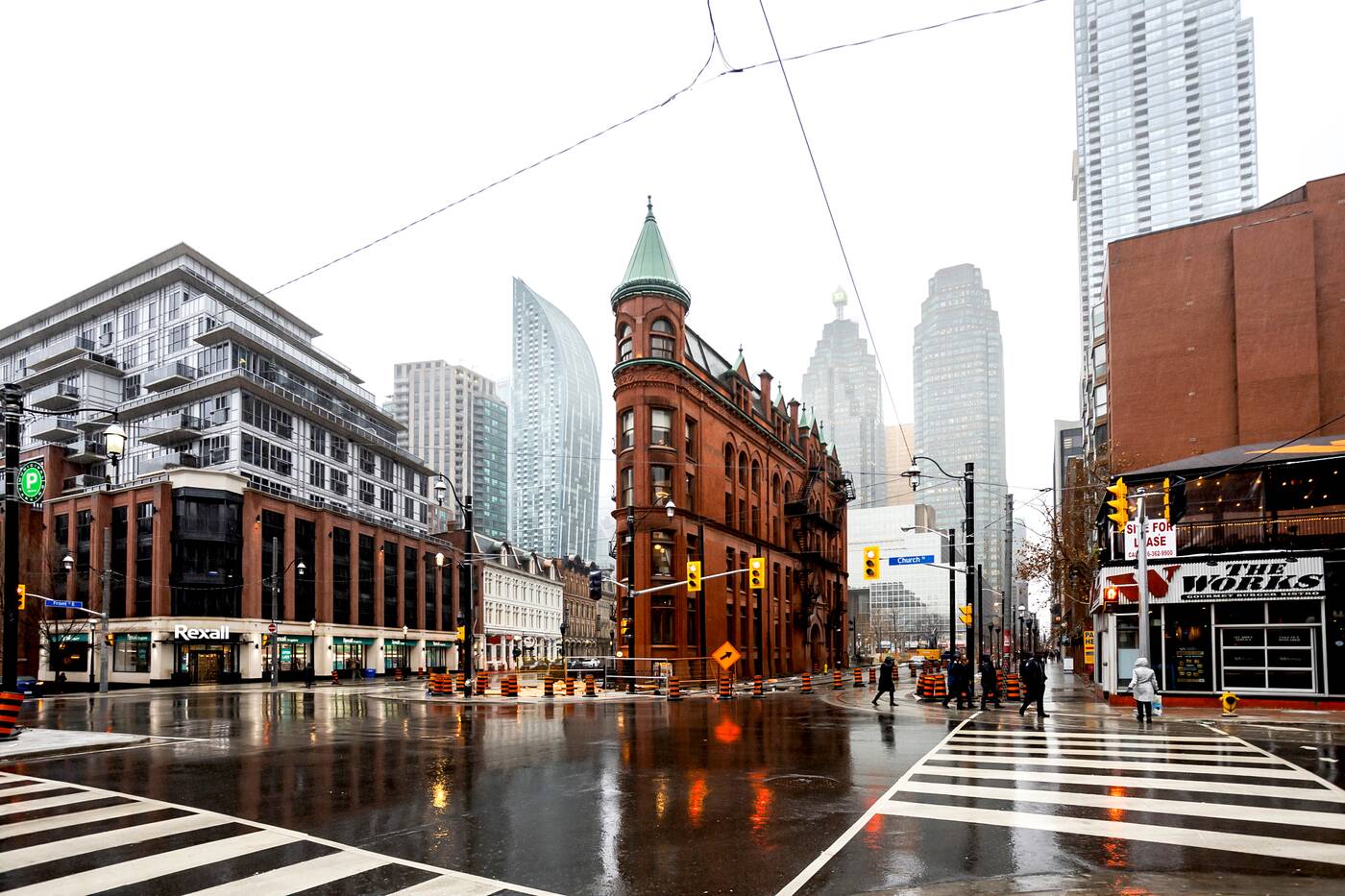Gooderham Building Map: Locate Convenient Access and Information About Fees.
Gooderham Building Map: Locate Convenient Access and Information About Fees.
Blog Article
Uncover the Rich Background Behind the Gooderham Building in Toronto
The Gooderham Structure, an exemplary indication of Richardsonian Romanesque architecture in Toronto, has a fabled past that prolongs past its striking red brick frontage. Appointed by the prominent Gooderham and Worts distillery in 1891, this building has actually played an essential duty in forming the city landscape of the St. Lawrence Market location. As we discover its origins, building importance, and social influence, one can not assist however examine just how this site continues to influence Toronto's identification and heritage. What keys exist within its wall surfaces that contribute to its enduring heritage?

Origins of the Gooderham Structure
Creating a lasting heritage, the Gooderham Structure, additionally called the Flatiron Structure, arised as an icon of Toronto's architectural evolution in the late 19th century. The structure's origins trace back to 1891 when it was commissioned by the Gooderham and Worts distillery, among copyright's biggest distilling companies. Designed by engineer David Roberts Jr. Gooderham Building address., the structure was distinctively positioned at the intersection of Front and Wellington Streets, making use of a triangular whole lot created by the merging of these thoroughfares
The building's building used local red block and terracotta, developing a distinctive aesthetic that matched the growing cityscape. Originally planned to house the Gooderham and Worts offices, the structure represented the prosperity of the distillery, which had actually ended up being a substantial contributor to Toronto's economic situation. Notably, the completion of the Gooderham Building accompanied a duration of rapid urbanization that identified the era.
The facility of this architectural treasure not just showcased innovative design yet additionally prepared for future developments in Toronto. Today, it stands as a testimony to the city's rich background and adaptability, remaining to attract visitors and admirers from around the world.
Architectural Importance
The building importance of the Gooderham Structure prolongs past its distinctive flatiron shape, showing the ingenious spirit of late 19th-century design. Finished in 1892, the framework exemplifies the Richardsonian Romanesque design, characterized by its robust stonework, rounded arcs, and intricate detailing. The vibrant usage of contrasting materials, particularly the cozy red block and limestone accents, boosts its visual appeal and shows the workmanship of the era.
The building's three-story design is noteworthy for its harmonious proportions and classy cornice, which add to its renowned silhouette against the Toronto sky line. The narrow whole lot on which it stands postured special difficulties, yet the architects, in this instance, made a framework that optimized the available room while preserving visual equilibrium.
Furthermore, the Gooderham Building is a testament to the versatility of building style in metropolitan environments. Its enduring visibility in the middle of modern developments illustrates the value of maintaining historic design as a way of recognizing a city's past. Today, it stays a precious spots, reflecting both the building fads of its time and the developing story of Toronto as a dynamic city center.
Role in Toronto's Advancement
Arising as a key player in Toronto's city landscape, the Gooderham Structure added considerably to the city's growth during the late 19th century. The structure was at first developed to serve as a warehouse for the Gooderham and Worts distillery, which was one of the biggest distilleries in the British Empire.
As the city expanded, the Gooderham Structure became an important part of the St. Lawrence Market area, which was a center of profession and commerce. Its one-of-a-kind building style and prominent existence attracted attention, affecting the layout of subsequent buildings in the location. The structure's survival via different economic shifts and city growths shows the resilience and versatility of Toronto's historical landscape. Essentially, the Gooderham Structure is not just a building landmark; it played a pivotal function fit Toronto's identification and economic development throughout a transformative duration in its background.
Cultural Impact and Legacy
Gooderham Building's distinct architectural design and historic significance have actually left an enduring mark on Toronto's cultural landscape. As one of the city's most identifiable landmarks, its special flatiron shape and complex brickwork exemplify the Victorian architectural trends of the late 19th century. This framework not just offers as an aesthetic support in the St. Lawrence community yet likewise embodies the spirit of an expanding city during an age of financial development.
The structure has actually ended up being a symbol of Toronto's abundant history, inspiring local musicians and photographers that seek to capture its beauty. Its existence has actually cultivated a sense of area identity, adding to the narrative of metropolitan development. The Gooderham Building has actually played an essential role in the tourist market, drawing in site visitors excited to discover its storied past and building beauty.
Along with its visual charm, the building encapsulates a narrative of durability and adaptation, as it has actually transitioned through different uses over the years - Gooderham Building address. Thus, the Gooderham Structure stands not just as a monument of architectural relevance yet also as a testament to the developing social heritage of Toronto

Reconstruction and Conservation Initiatives
Various remediation this page and preservation initiatives have actually been undertaken to guarantee the Gooderham Structure remains an essential part of Toronto's building heritage. Initially completed in 1892, the structure has actually undertaken significant restorations to resolve architectural concerns while retaining its historic honesty. One of the most remarkable restoration occurred in the late 20th century when the structure was diligently reconditioned to meet contemporary safety and security requirements without endangering its initial design components.
These initiatives consisted of fixing the unique red-brick façade, restoring the famous triangular shape, and protecting the intricate stonework details. Additionally, the building's interior has seen cautious updates that appreciate its historical value, ensuring that initial attributes such as wood beam of lights and decorative moldings are maintained.
The Gooderham Building is now secured as a designated heritage building under the Ontario Heritage Act, which helps protect it from unsuitable changes. Neighborhood engagement has played a vital function in these conservation initiatives, with local advocacy teams raising understanding about the structure's historical significance. Consequently, the Gooderham Building stands not only as a functional space yet additionally as a testimony to Toronto's abundant building history and enduring cultural tradition.
Verdict

Please visit one of our local supporters - Gamerama And The Repair Store - Iphone Repair
Report this page